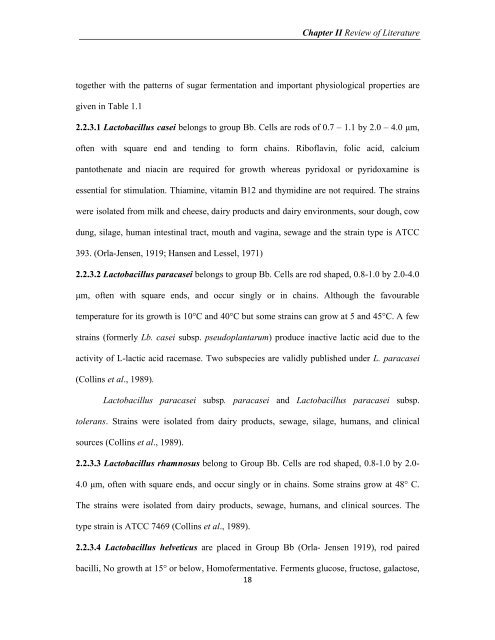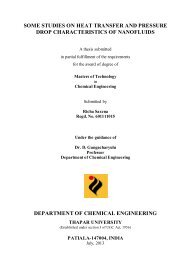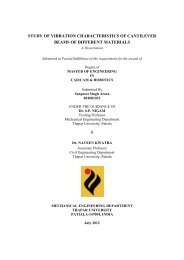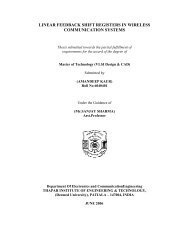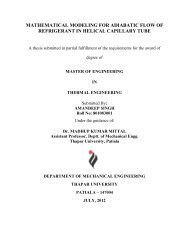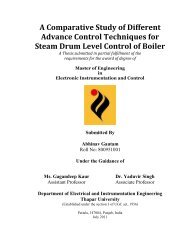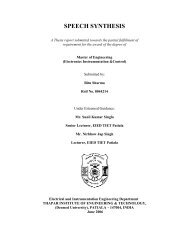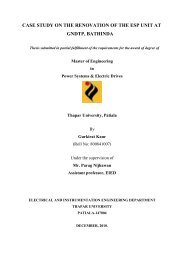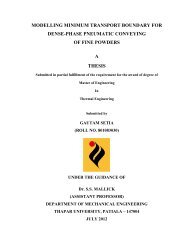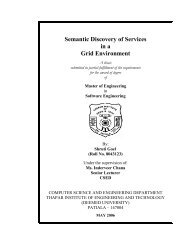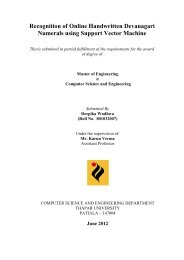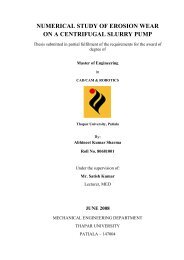from indigenous fermented foods and human gut ... - Thapar University
from indigenous fermented foods and human gut ... - Thapar University
from indigenous fermented foods and human gut ... - Thapar University
You also want an ePaper? Increase the reach of your titles
YUMPU automatically turns print PDFs into web optimized ePapers that Google loves.
Chapter II Review of Literature<br />
together with the patterns of sugar fermentation <strong>and</strong> important physiological properties are<br />
given in Table 1.1<br />
2.2.3.1 Lactobacillus casei belongs to group Bb. Cells are rods of 0.7 – 1.1 by 2.0 – 4.0 μm,<br />
often with square end <strong>and</strong> tending to form chains. Riboflavin, folic acid, calcium<br />
pantothenate <strong>and</strong> niacin are required for growth whereas pyridoxal or pyridoxamine is<br />
essential for stimulation. Thiamine, vitamin B12 <strong>and</strong> thymidine are not required. The strains<br />
were isolated <strong>from</strong> milk <strong>and</strong> cheese, dairy products <strong>and</strong> dairy environments, sour dough, cow<br />
dung, silage, <strong>human</strong> intestinal tract, mouth <strong>and</strong> vagina, sewage <strong>and</strong> the strain type is ATCC<br />
393. (Orla-Jensen, 1919; Hansen <strong>and</strong> Lessel, 1971)<br />
2.2.3.2 Lactobacillus paracasei belongs to group Bb. Cells are rod shaped, 0.8-1.0 by 2.0-4.0<br />
μm, often with square ends, <strong>and</strong> occur singly or in chains. Although the favourable<br />
temperature for its growth is 10°C <strong>and</strong> 40°C but some strains can grow at 5 <strong>and</strong> 45°C. A few<br />
strains (formerly Lb. casei subsp. pseudoplantarum) produce inactive lactic acid due to the<br />
activity of L-lactic acid racemase. Two subspecies are validly published under L. paracasei<br />
(Collins et al., 1989).<br />
Lactobacillus paracasei subsp. paracasei <strong>and</strong> Lactobacillus paracasei subsp.<br />
tolerans. Strains were isolated <strong>from</strong> dairy products, sewage, silage, <strong>human</strong>s, <strong>and</strong> clinical<br />
sources (Collins et al., 1989).<br />
2.2.3.3 Lactobacillus rhamnosus belong to Group Bb. Cells are rod shaped, 0.8-1.0 by 2.0-<br />
4.0 μm, often with square ends, <strong>and</strong> occur singly or in chains. Some strains grow at 48° C.<br />
The strains were isolated <strong>from</strong> dairy products, sewage, <strong>human</strong>s, <strong>and</strong> clinical sources. The<br />
type strain is ATCC 7469 (Collins et al., 1989).<br />
2.2.3.4 Lactobacillus helveticus are placed in Group Bb (Orla- Jensen 1919), rod paired<br />
bacilli, No growth at 15° or below, Homofermentative. Ferments glucose, fructose, galactose,<br />
18


